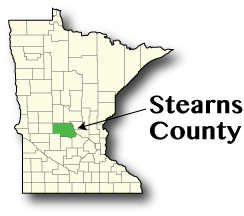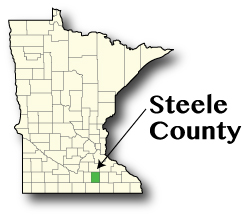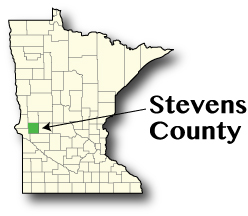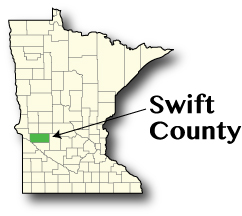by Cameron Macht
October 2018

Stearns County was home to several indigenous tribes including the Ojibwa, Dakota, Sioux, and Chippewa long before the first European immigrants started to arrive in the 1850s. From there, early settlers were drawn by the county's excellent farmland1, which still keeps the county ranked first in the state for the total value of agricultural products sold 2. But in addition to rural areas and farms, the county seat of St. Cloud is now the 10th largest city in the state with 68,000 residents, and, with Benton County, is home to one of only five Metropolitan Statistical Areas (MSAs) located entirely in Minnesota.
Closing in on 160,000 people in 2017, Stearns County is the seventh largest county of the 87 in the state. After gaining nearly 25,000 new residents, it was also the 11th fastest growing county, rising 18.5 percent since 2000. As a result, the county's labor force has grown to just under 90,000 workers, which was about 11,000 more workers than in 2000, although growth rates have slowed in recent years. The county's 3.5 percent unemployment rate reflects a tightening labor market in a growing economy.
With about 86,500 jobs at 4,300 business establishments, Stearns County also had the seventh largest economy in the state in 2017. Local employers added close to 5,500 jobs from 2012 to 2017, a 6.8 percent increase that nearly matched the state's job growth rate. Health Care and Social Assistance is the largest employing industry, accounting for one in every five jobs, and nearly half (44%) of the net new jobs added in the county over the past five years. Retail Trade and Manufacturing both had over 11,000 jobs in the county, with Retail employers finally starting to recover from the Great Recession. Home to several colleges and universities in addition to growing elementary and secondary schools, Stearns County also has a high concentration of employment in Educational Services.
Stearns County has one of the most racially and ethnically diverse populations in Greater Minnesota and has benefited from significant increases in the number of people of other races and from foreign countries in recent years. Despite domestic out-migration, an important part of Stearns County's population growth came from international in-migration. After increasing almost 50 percent from 2010 to 2016, about 5.6 percent of the county's population is now foreign-born with the largest number coming from Africa, followed by Asia and Latin America.
| 2017 Estimates | Stearns County | Minnesota |
|---|---|---|
| Population | 157,822 | 5,576,606 |
| Labor Force | 89,109 | 3,063,604 |
| Average Unemployment | 3.5% | 3.6% |
| Median Household Income | $56,977 | $63,217 |
| Cost of Living, Individual | $27,558 | $31,656 |
| Cost of Living, Average Family | $46,702 | $57,624 |
| Source: U.S. Census Bureau, DEED Local Area Unemployment Statistics, DEED Cost of Living | ||
| Industry | |||||
|---|---|---|---|---|---|
| Top Employing Industries | 2017 Annual Data | 2012-2017 | |||
| Number of Firms | Number of Jobs | Average Wage | Change in Jobs | ||
| Total, All Industries | 4,299 | 86,484 | $45,944 | 5,484 | |
| Health Care and Social Assistance | 427 | 17,299 | $56,786 | 2,417 | |
| Retail Trade | 646 | 11,861 | $28,409 | 515 | |
| Manufacturing | 265 | 11,301 | $50,165 | -109 | |
| Educational Services | 92 | 7,393 | $47,683 | 73 | |
| Source: DEED Quarterly Census of Employment and Wages (QCEW) program | |||||
1History of Stearns County.
2U.S. Department of Agriculture. Stearns County Minnesota. 2012 Census of Agriculture County Profile.

Steele County was organized in 1855 from a portion of Rice County, one year after the city of Owatonna was first settled along the Straight River. From 1898 to 1940 Steele County was known as the "Butter Capitol of the World" after local butter makers won gold medals in World's Fairs and because Reuben Disbrow invented the combined butter churn - patented in 1896 and manufactured by Owatonna Manufacturing Company - which revolutionized the dairy industry. Down from a peak of 24 creameries, Steele County now has just one remaining in operation. Steele County is also the founding location of major national companies including Jostens, Malt-O-Meal, and Federated Insurance1.
With more than 25,750 people in 2017, the county seat of Owatonna is the 40th largest city in Minnesota, but the second largest city in the state that is located outside a metropolitan statistical area. It is also one of the 15 Micropolitan Statistical Areas in the state.
Steele County's labor force has grown by just over 2,000 additional workers from 2000 to 2017, but peaked with 21,570 workers in 2012. The county then saw labor force declines in three of the last five years, but big gains from 2015 to 2017 have brought the county within 50 workers of the previous record high. Population projections from the State Demographic Center forecast a slight 1.4 percent labor force decline from 2020 to 2030.
Manufacturing is still the largest employing industry, providing over 28 percent of all jobs in the county. That was the sixth highest reliance on Manufacturing of the 87 counties in the state. Despite declines from 6,056 jobs in 2008 to a low point of 5,004 jobs in 2011 during the Great Recession, Steele County's Manufacturing industry has mostly recovered the jobs lost and now has the same number of Manufacturing jobs as in 2007.
Retail Trade is the second largest employing industry in the county, accounting for 14 percent of total employment. But while wages in Manufacturing were relatively high, wages in Retail Trade were relatively low, and retailers were cutting jobs over the past five years. The most severe job declines in Steele County occurred in Administrative Support and Waste Management Services, which includes temporary staffing services.
| 2017 Estimates | Steele County | Minnesota |
|---|---|---|
| Population | 36,887 | 5,576,606 |
| Labor Force | 21,526 | 3,063,604 |
| Average Unemployment | 3.4% | 3.6% |
| Median Household Income | $58,141 | $63,217 |
| Cost of Living, Individual | $27,407 | $31,656 |
| Cost of Living, Average Family | $46,929 | $57,624 |
| Source: U.S. Census Bureau, DEED Local Area Unemployment Statistics, DEED Cost of Living | ||
| Industry | |||||
|---|---|---|---|---|---|
| Top Employing Industries | 2017 Annual Data | 2012-2017 | |||
| Number of Firms | Number of Jobs | Average Wage | Change in Jobs | Percent Change | |
| Total, All Industries | 962 | 20,915 | $44,843 | -688 | -3.2% |
| Manufacturing | 70 | 5,874 | $52,714 | 806 | 15.9% |
| Retail Trade | 162 | 2,915 | $24,854 | -116 | -3.8% |
| Health Care and Social Assistance | 90 | 2,387 | $48,268 | 140 | 6.2% |
| Admin. Support and Waste Management | 34 | 1,737 | $27,681 | -1,615 | -48.2% |
| Source: DEED Quarterly Census of Employment and Wages (QCEW) program | |||||
1Steele County Historical Society.

Established in 1862, Stevens County is actually the second time a county in Minnesota was named for statesman Isaac Ingalls Stevens, after a legislative clerical error denied him that honor in 1855 for Stearns County.1 Located in the old Carnegie Library in the county seat of Morris, the Stevens County Historical Society & Museum has a "Hall of Honor" focused on "Men and Women of the Land" who made important contributions to the success of Stevens County.2
Home to the Morris campus of the University of Minnesota, Stevens County has the third lowest median age of the 87 counties in the state at 33.1 years. In addition to these students, however, the county also had a higher percentage of the population aged 65 years and over than the state. With low taxes, transportation, and child care costs in comparison to other counties, Stevens County reported the lowest cost of living in the state for a typical family.
After seeing a slight increase from 1950 to 1980, Stevens County's population dropped during the farm crisis of the 1980s and has declined even further in the past 27 years. The county lost exactly 1,000 people since 1990 to 9,634 people in 2017. Despite the population loss, Stevens County's labor force actually increased by 360 workers from 1990 to 2017, although all of the gains came before 2000.
With a declining population and labor force but a growing economy, Stevens County has had either the second or third lowest unemployment rate in the state over most of the past decade. The county's annual unemployment rate has been 3 percent or lower since 2015 and even dropped below 2 percent in three of the last 12 months.
Manufacturing is the largest employing industry in Stevens County, with 858 jobs at 16 firms. The largest subsector is Fabricated Metal Product Manufacturing, but the county's Cement and Concrete Product Manufacturing subsector is the most distinguishing, with a location quotient of 17.4 compared to the state. With six elementary and secondary schools providing 344 jobs and one university providing 487 jobs, Stevens County also has a higher concentration of employment in Educational Services than the state. Strangely, the county saw a decline in Health Care and Social Assistance employment overall, despite an increase in hiring at nursing and residential care facilities.
| 2017 Estimates | Stevens County | Minnesota |
|---|---|---|
| Population | 9,634 | 5,576,606 |
| Labor Force | 5,610 | 3,063,604 |
| Average Unemployment | 2.8% | 3.6% |
| Median Household Income | $55,941 | $63,217 |
| Cost of Living, Individual | $25,261 | $31,656 |
| Cost of Living, Average Family | $41,053 | $57,624 |
| Source: U.S. Census Bureau, DEED Local Area Unemployment Statistics, DEED Cost of Living | ||
| Industry | |||||
|---|---|---|---|---|---|
| Top Employing Industries | 2017 Annual Data | 2012-2017 | |||
| Number of Firms | Number of Jobs | Average Wage | Change in Jobs | Percent Change | |
| Total, All Industries | 338 | 5,527 | $44,821 | 294 | 5.6% |
| Manufacturing | 16 | 858 | $55,611 | 32 | 3.9% |
| Educational Services | 7 | 832 | $34,852 | 138 | 19.9% |
| Health Care and Social Assistance | 31 | 666 | $33,704 | -126 | -16.0% |
| Retail Trade | 39 | 497 | $30,649 | 48 | 10.7% |
| Source: DEED Quarterly Census of Employment and Wages (QCEW) program | |||||
1History. Stevens County Minnesota.
2Men & Women of the Land – Hall of Honor. Stevens County Historical Society & Museum.

Swift County is primarily an agricultural county, with 564 of the county's 752 square miles in farms. Several cities and townships in Swift County gained their names from Ireland – including Dublin, Cashel, Clontarf, Kildare, and Tara townships. Swenoda township, which is in the process of acquiring a 9,500 head dairy farm that is similar to four other large dairies in the region1, has a composite name that is a compliment to its Swedish, Norwegian, and Danish settlers.2
After losing just over 2,500 people from 2000 to 2017, Swift County was the fastest declining county in the state. However, much of that loss was caused by the closing of the Prairie Correctional Facility in Appleton, a 1,600 bed private prison that shut down in 2010. In addition to the loss of those "residents" from the county, the region also suffered the loss of hundreds of jobs. State legislators have recently explored options for leasing, purchasing, or operating the facility, but couldn't reach agreement during the 2018 session.
Unlike the rest of the state, Swift County's population became less racially diverse since 2000, losing residents of every race group including White, Black or African American, American Indian, Asian, Some Other Race, and Two or More Races. People of Hispanic or Latino origin saw the only increase, rising 27 percent through 2016, and now 4.3 percent of the county's population identify as Hispanic or Latino.
Swift County's labor force has also been declining over time, dropping to a low of 4,849 available workers in 2014 before climbing back to 5,073 workers in 2017. In contrast, the county's unemployment rate jumped in 2010 and has stayed at least 0.6 percent above the state rate for the past seven years.
With a cluster of strength in Agricultural Machinery, Manufacturing is the largest employing industry in Swift County with 544 jobs at 19 firms. Wholesale Trade is the next largest, with high concentrations in Farm Product Raw Material Wholesalers and Machinery, Equipment, and Supplies Wholesalers. Although not listed in the top employing industries table, Education and Health Care Services are important employers in the county, accounting for about 300 jobs each at elementary and secondary schools and health care and social assistance providers.
| 2017 Estimates | Swift County | Minnesota |
|---|---|---|
| Population | 9,407 | 5,576,606 |
| Labor Force | 5,073 | 3,063,604 |
| Average Unemployment | 4.2% | 3.6% |
| Median Household Income | $49,956 | $63,217 |
| Cost of Living, Individual | $25,702 | $31,656 |
| Cost of Living, Average Family | $43,738 | $57,624 |
| Source: U.S. Census Bureau, DEED Local Area Unemployment Statistics, DEED Cost of Living | ||
| Industry | |||||
|---|---|---|---|---|---|
| Top Employing Industries | 2017 Annual Data | 2012-2017 | |||
| Number of Firms | Number of Jobs | Average Wage | Change in Jobs | Percent Change | |
| Total, All Industries | 333 | 3,680 | $39,264 | 53 | 1.5% |
| Manufacturing | 19 | 544 | $55,167 | -88 | -13.9% |
| Wholesale Trade | 25 | 343 | $65,826 | 4 | 1.2% |
| Retail Trade | 33 | 326 | $19,757 | 10 | 3.2% |
| Public Administration | 16 | 311 | $37,605 | -8 | -2.5% |
| Source: DEED Quarterly Census of Employment and Wages (QCEW) program | |||||
1"Riverview plans fifth large dairy west of Willmar" West Central Tribune newsroom. Nov. 21, 2017.
2History of Swift County. Swift County Minnesota.
3Prairie Correctional Facility. West Central Tribune.